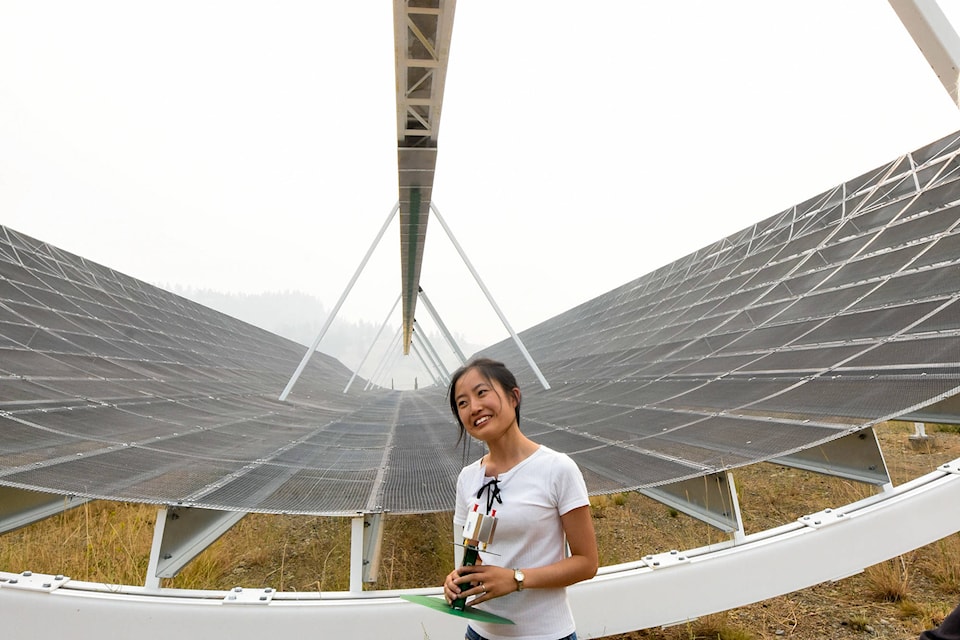The astrophysical observatory on White Lake Road is once again making (and receiving) waves on an intergalactic scale.
Thursday afternoon Kirsty Duncan, federal minister of science, helped install the final section of antenna on Canada’s newest and largest radio telescope at the (DRAO).
The Canadian Hydrogen Intensity Mapping Experiment (CHIME) will map cosmic structure over the largest volume of the universe ever observed and act as a time machine to help scientists create a three-dimensional map of the universe extending deep into time and space.
“This is important, it’s going to allow us to answer some of the most profound questions — how this universe has changed, how it impacts on our world today,” said an emotional Duncan. “It’s going to allow our researchers to better understand the dark energy and how it’s driving the accelerating expansion of the universe.
“This really is home grown. This is a day for all Canadians to be so proud of the work that has been done here. It is an honour and it is humbling and awe inspiring to meet the scientists who had this vision to build this, something that is unique in the world.”
CHIME, built at DRAO, is a highly sensitive radio telescope which collects very faint signals from space and is a novel instrument with no moving parts unlike other radio telescopes.
The four, 100-metre long, half-cylinder shaped reflectors (the size of five NHL rinks) have a series of antennas which all feed the raw data (radio waves) to a central computer through miles of cable. Each reflector collects radio waves and focuses them on 512 inputs. As the Earth turns, each input scans a north-south strip of sky so each day the telescope scans the entire visible sky.
Some time ago scientists found that the universe is expanding and the rate of expansion is accelerating.
In the 1990s the discovery of dark energy was made, surprising astronomers who expected cosmic expansion would slow down as gravity pulls matter in the universe back in on itself, much the way a ball thrown in the air would eventually reverse course and fall.
However dark energy, estimated to make up 68 per cent of all energy, in the universe, appears to be counter-acting gravity, pushing matter apart and expanding the universe.
Despite its prevalence, little is known about dark energy and that’s where CHIME comes in.
Because of the vastness of the universe it has taken many years for radio light to arrive at CHIME so it will see light that left the most distant cosmic structures.
“This telescope will measure the exceleration of the universe between several billion to 11 billion years ago,” said DRAO director Sean Dougherty. “And hopefully, deduce this mystical property of the universe called dark energy, which we know very little about.”
It is hoped too the powerful instrument will shed light on another astronomical anomaly, fast radio bursts.
“They only last milliseconds, but they are incredibly powerful,” said Dougherty. “Associated with compact, spinning objects they seem to repeat and are not as a result of cataclysmic events.”
The new instrument is able to peer into a period of history billions of years ago in the universe’s history, to see if the dark energy is changing with time as the universe expands.
Almost daily from Penticton, scientists will now be able to monitor the radio waves from the spinning neutron stars in this galaxy which pierce the sky like a beam from a lighthouse.
The waves are called source pulsars, which act like cosmic clocks leading to new insights.
Cost-effective for a telescope of this scale, checking in with a price tag of about $16 million, CHIME’s technology draws on mass produced signal amplifiers developed for use in cell phones and on high-end graphics cards developed for video game processors, exploiting consumer technologies to scan the cosmos.
To process this data, CHIME’s computers perform seven quadrillion multiplications per second, which, to put it into perspective, is the equivalent to everyone on earth performing one million multiplication problems every second.
The White Lake site was chosen because it is a radio-quiet zone and is protected from radio frequency interference by the surrounding hills as well as legislation at all levels of government restricting activities which would interfere.
On-site computers are surrounded by metal screening and cell phones must be turned off because CHIME is so sensitive it could detect a single cell phone located 20 times as far away as the moon.
“With this being a world leading experiment, it’s really going to put the White Lake basin to the forefront in the world for doing unique experiments,” said Dougherty. “It’s also a great opportunity too for Canada in developing the next generation of leading scientists, young people who are really keen on pushing the boundaries of science.”



